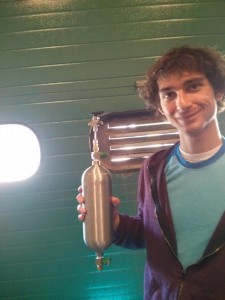The first step of the project was making the triple standard gas containing N20, SF6, and CF3SF5. We needed CF3SF5 in the cocktail so that we could find its diffusion coefficient (the purpose of the experiment). We added N20 and SF6 to the mixture so that we could analyze the results; if the experimental diffusion coefficients for these chemicals matched the literature, then we knew that the diffusion coefficient for CF3SF5 was correct as well.
First, we added CF3SF5 to the cylinder. We connected a gas cylinder containing CF3SF5 to a control loop and let the CF3SF5 pass through the loop. We then purged the control loop into a gas cylinder and brought the cylinder to a gauge pressure of -25 mm Hg. We let the gas settle in a room with a temperature of 21.8o C and a pressure of 29.99 in Hg and then vented the cylinder to atmospheric pressure.
Next, we connected a gas cylinder containing pure SF6 to the cylinder containing the CF3SF5. We added SF6 to the mixture until the total pressure was 60 psi. The mixture settled into a room with a temperature of 21.0o C and a pressure of 29.84 in Hg and then was vented to the atmosphere.
We then added pure nitrogen to the cylinder and pressurized the mixture to 60 psi. We allowed the mixture time to settle and then vented it to the atmosphere. We repeated this process with nitrogen two more times.
Lastly, we added pure N2O to the mixture until the total pressure of the system reached 88 psi. We then pressurized the system with nitrogen to increase the pressure to 2200 psi.
Here’s a picture of the cylinder containing the final triple standard:
